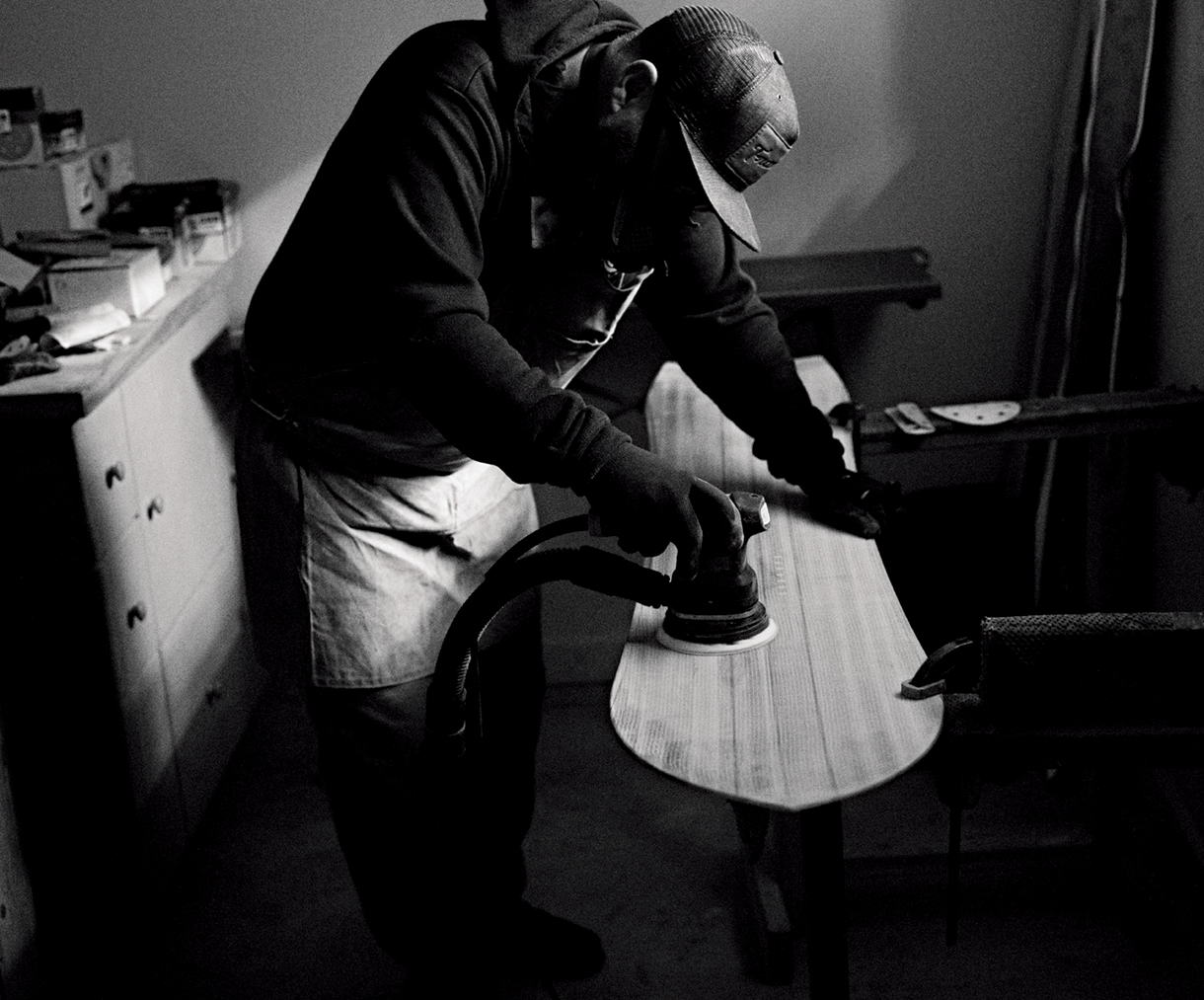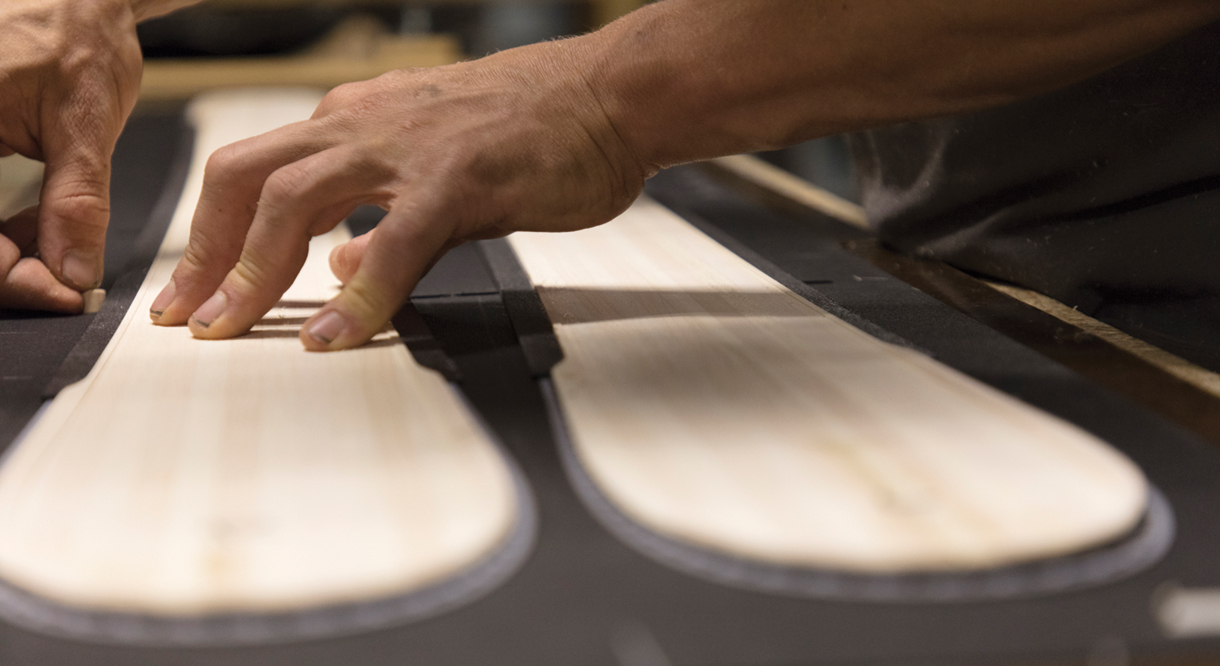
Switching Gears
Make the change from off-the-rack skis, snowboards, and boots to custom-built equipment.

Custom Ski Boots
As the owner of Wagner Skis (wagnerskis.com), the world’s best-known custom ski maker, Pete Wagner wants to sell skis, yet he firmly believes that if you go bespoke for one thing it should be boots. “Forty years ago, people thought, ‘Custom ski boots? That’s only for racers. I’m not good enough.’ But now it is pretty standard and the future of skiing,” says Wagner. “It’s the single most important item, the foundation. You’ll be warmer, more comfortable, and more precise, and if you don’t get them it’s going to hold you back.” In fact, many skiers have been said to jump a full point or two on the nine-point scale used to rate ability.
Less than a quarter of the population has “normal” feet, and most people pronate or overpronate (low arches, feet tilted inward), while a smaller number supinate (high arches, tilted outward). But skis turn more precisely than ever, based on edge pressure applied by tipping the inside or outside of the boot sole. That means most skiers are unconsciously turning both skis inward toward each other (or outward if they supinate) when they think they are going straight. The mind makes the body counter this by rotating the femurs and using the big muscles of the legs, which is why many skiers get exhausted so quickly and wake up with sore thighs. This habit also hampers their ability to turn. Skis are designed for the neutral feet few skiers have, and the way to get neutral is through a custom orthotic footbed insert.
The second piece of the equation is the removable foam boot liner inside the hard-plastic shell. Tailored liners are foam injected around the foot while in the boots, so they perfectly mirror every contour of the foot, calf, and especially ankle bones. This results in a much more comfortable boot that also transfers movements more quickly and precisely to the shell for better control. It’s more comfortable, performs better, and because most cold toes come from circulation impingement of an imperfect fit, it’s warmer.
Some ski towns have a boot-fitting guru that locals swear by, and such standouts include Bootdoctors in Telluride and Bootech in Aspen. But for most skiers, far and away the best and easiest solution is Surefoot (surefoot.com), the only global custom boot retailer and longtime No. 1 in the United States. Surefoot has been developing proprietary high-tech analysis equipment and liners for decades, and every store has two 3-D scanners: one to map the bottom of the foot and create computer-milled custom orthotics, and the second to precisely measure the rest of the foot, including obscure stats such as instep height, ball girth, and ball width. They just introduced the latest generation of high-end proprietary downhill liners in regular and heated versions, plus a race model and ultralight alpine touring version with a removable tongue. These are custom foamed around the foot and paired with the best shell to fit you, chosen from popular models by the top manufacturers, including Lange, Nordica, Tecnica, K2, Full Tilt, and Dalbello.
“Build a house without a foundation and you will never have a good house. It’s the same with the orthotic. We call it ‘The Power of Neutral,’ and it’s going to make any boot feel and perform much better,” says expert fitter Ray Rice, Surefoot’s longest-serving employee, who has fitted numerous Olympic medalists, pros, and even world champion marathoners. “Most of the world’s best athletes were born with perfect neutral feet, and there’s a reason we call them ‘naturals.’ As a result, ski boots from all major manufacturers are designed to fit the neutral foot. But the problem is, about 95 percent of all people don’t have them. Picking ski boots off the rack is trying to fit a round peg in a square hole.
“The combination of the orthotic, the custom liner, and any changes we have to make to the shell let us achieve our goal: We want you to stand comfortably with no shell impingement on your bones, which usually occurs at the ankle,” explains Rice. “This allows the skier to be in a neutral, athletic stance without cutting off circulation or causing discomfort.” After scanning over a million feet, Surefoot has finely honed bespoke bootmaking into a one-stop process, and when you buy from any of its 24 shops worldwide, including the marquee ski towns (Vail, Whistler, Jackson, Park City, Verbier, Courchevel, Val D’Isere, etc.) and cities such as New York, London, and Los Angeles, you can get adjustments, repairs, or support at the resort you are visiting, with your scans all computerized. They also make custom snowboard boot liners, but snowboarders have to bring in their boots. “Snowboard boots are more comfortable than ski boots, but they’re still not that comfortable,” adds Rice. “My wife is a snowboarder and she won’t go out without them.” Complete custom ski boots cost $1,100–$1,400.

Custom Skis & Snowboards
Driven by automated technology and online retailing, the fastest-growing segment of the bespoke snow equipment market is the custom or semi-custom ski or snowboard. In these cases, producers make a range of base models in different combinations of tip, tail, and waist width, and offer it in several lengths, just like an off-the-rack ski. But these can be customized to offer different camber (the slight dome shape where the binding area is raised off the ground when the ski lays flat), rocker (reverse of camber, a bowl shape), flex (stiffness), and shape/style of tips and tails. You can often upgrade materials, elevating the performance of a basic (wood core or triaxial fiberglass) construction with the addition of metal layers, carbon fiber, visco-elastically dampened carbon, or high-tech wonder materials like Titanal and Countervail. You can choose different base materials depending on the desired characteristic (for example, more durable versus faster), and, of course, custom graphics, either chosen from the manufacturer’s library or art you supply (images of pet dogs are especially popular).
While off-the-rack skis are designed for different terrain, snow conditions, and ability levels, they cannot be designed to fit different bodies, and take an inherently one-size-fits-all approach that cannot match the performance of a properly designed custom version. But for many of the semi-custom manufacturers, options are limited and much of the quality comes from the fitting process, and determining your needs. One of the best is Crested Butte, Colorado–based Romp Skis (rompskis.com; $1,050–$1,450), whose designers conduct a lengthy phone interview, asking detailed questions such as what are your favorite mountains, conditions, terrain, and even individual trails, in addition to learning body weight, height, ability, and goals. Their ski designers use their expertise to advise on the perfect skis, since even the most avid skiers do not know what things like Titanal are.
The best option is truly custom, such as those produced by industry leader Wagner Skis at its Telluride factory. Wagner is the gold standard and object of chairlift envy, offering the most options with more than 200 material combinations and infinite designs. Everything is changeable, including sidecut (the difference in width dimensions from tip to tail, from hourglass to nearly straight skis) and length, things most “custom” manufacturers cannot do.
Wagner began as an engineer in the heavily customized golf shaft industry, and took the same approach used for modern golf fitting. He has created a “Skier DNA” assessment model that takes all your likes, dislikes, and quirks to compute precise recommendations, which you then discuss with a designer who explains the complex options. Wagner’s extremely precise machines help deliver truly one-of-a-kind, ultra-high-performance skis in just three weeks—or even faster, since they are often purchased for special trips. “People call and say, ‘we’re going heli-skiing in two weeks,’ and I try to help them out,” Wagner says.
“Whether it’s skis or boots, equipment that fits you properly gives increased comfort, control, balance, and efficiency. Our skis don’t just fit you better, they fit you perfectly,” he says. “What a lot of our customers tell me is that they notice a bigger sweet spot, the skis work better in more different conditions; it’s more of a true all-mountain experience.” Nonetheless, a very high repeat rate means several customers have two, three, or four pairs for everything from firm Eastern conditions to bottomless heli-powder. Wagner skis start at $1,750 before bindings, average around $2,100, and can run over $3,000.
“There’s no risk because we guarantee it. We will make you another pair or give you your money back, but we have a really good track record of getting it right the first time. We did more sales last year than ever before, and we had three returns.” The ultimate is to go visit and place your order in Telluride, but less than 1 in 20 customers does, and Wagner Skis ships all over the world. In 14 years, Wagner has made over 15,000 pairs of skis—no two the same. The company is known for its intricately grained real wood veneer top sheets, so popular and distinctive they can instantly be identified as “Wagners” at resorts worldwide. Custom graphics have included everything from fine art (Edvard Munch’s The Scream) to customer art.
There are even fewer true custom snowboard makers, and among these Mikey Franco of Franco Snowshapes (francosnowshapes.com) is far and away the most famous, with his workshop just 12 miles south of the Jackson Hole resort, where he used to teach. His process is more artisanal and less scalable because it is based on his personal assessment of your needs, and this is especially true with the unique “Franco Experience.”
For this, customers go to Wyoming and spend a full day boarding with him ($1,000 extra, including coveted VIP first tram access), while Franco performs an in-depth movement analysis to make recommendations. But he can only do a few of those days each winter, and, like Wagner, most buyers complete his online Rider Genome Profile and then are interviewed by phone. In either case, he makes every board by hand to exacting specifications.
“I want it to be like that perfect surfboard, made one of a kind by a great shaper, but we didn’t have that in snowboarding,” says Franco. “I also want you to keep this board forever, which is why I make it as perfect as I can and give a lifetime guarantee. We’re making a personalized flex pattern and damping profile based on your stance width and length by using the best existing technologies, like Titanal.” Franco also does a lot of exposed wood grain boards (going as far as steam-bending the cherry himself), which explains why he only makes about 50 a year, averaging $3,200 and requiring from four weeks to four months to produce, depending on when you place the order.
“When you go into a store, you are buying what a designer intended the equipment to be used for, not what you intend to use it for,” says Franco. “Our premise is that I spent most of my life teaching or guiding snowboarding, and I can help you figure out what is best for you. The moment you step onto the snowboard it does what you want, no surprises. I don’t even like the word ‘custom;’ I prefer ‘tailored’ or ‘fitted,’ because I am making a snowboard the world has never seen before, every single time, and just for you.”




